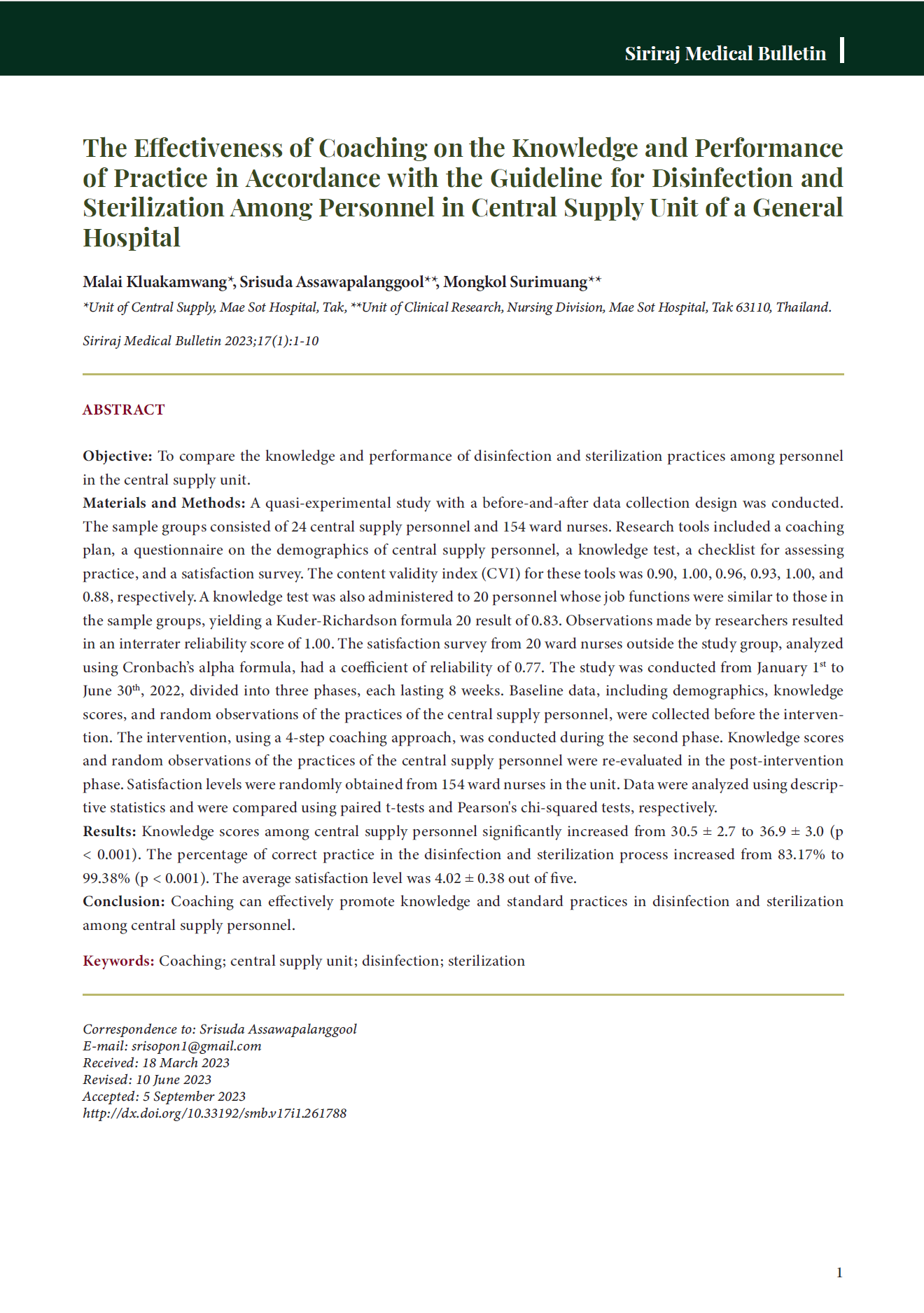The Effectiveness of Coaching on the Knowledge and Performance of Practice in Accordance with the Guideline for Disinfection and Sterilization Among Personnel in Central Supply Unit of a General Hospital
Main Article Content
Abstract
Objective: To compare the knowledge and performance of disinfection and sterilization practices among personnel in the central supply unit.
Materials and Methods: A quasi-experimental study with a before-and-after data collection design was conducted. The sample groups consisted of 24 central supply personnel and 154 ward nurses. Research tools included a coaching plan, a questionnaire on the demographics of central supply personnel, a knowledge test, a checklist for assessing practice, and a satisfaction survey. The content validity index (CVI) for these tools was 0.90, 1.00, 0.96, 0.93, 1.00, and 0.88, respectively. A knowledge test was also administered to 20 personnel whose job functions were similar to those in the sample groups, yielding a Kuder-Richardson formula 20 result of 0.83. Observations made by researchers resulted in an interrater reliability score of 1.00. The satisfaction survey from 20 ward nurses outside the study group, analyzed using Cronbach’s alpha formula, had a coefficient of reliability of 0.77. The study was conducted from January 1st to June 30th, 2022, divided into three phases, each lasting 8 weeks. Baseline data, including demographics, knowledge scores, and random observations of the practices of the central supply personnel, were collected before the intervention. The intervention, using a 4-step coaching approach, was conducted during the second phase. Knowledge scores and random observations of the practices of the central supply personnel were re-evaluated in the post-intervention phase. Satisfaction levels were randomly obtained from 154 ward nurses in the unit. Data were analyzed using descriptive statistics and were compared using paired t-tests and Pearson's chi-squared tests, respectively.
Results: Knowledge scores among central supply personnel significantly increased from 30.5 ± 2.7 to 36.9 ± 3.0 (p < 0.001). The percentage of correct practice in the disinfection and sterilization process increased from 83.17% to 99.38% (p < 0.001). The average satisfaction level was 4.02 ± 0.38 out of five.
Conclusion: Coaching can effectively promote knowledge and standard practices in disinfection and sterilization among central supply personnel.
Article Details

This work is licensed under a Creative Commons Attribution-NonCommercial-NoDerivatives 4.0 International License.
References
สถาบันบำราศนราดูร. คู่มือวินิจฉัยการติดเชื้อในโรงพยาบาล. สำนักพิมพ์อักษรกราฟฟิคแอนด์ดีไซน์: สถาบันบำราศนราดูร กรมควบคุมโรค กระทรวงสาธารณสุข; 2561.
Rutala WA, Weber DJ. Disinfection and sterilization in healthcare facilities. In: Jarvis WR, editor. Hospital Infection. 6 ed. Philadelphia: Wolters Kluwer; 2014. p. 293-310
Gransden WR, Webster M, French GL, Phillips I. An outbreak of Serratia marcescens transmitted by contaminated breast pumps in a special care baby unit. J Hosp Infect. 1986 Mar;7(2):149-54.
Cefai C, Richards J, Gould FK, McPeake P. An outbreak of Acinetobacter respiratory tract infection resulting from incomplete disinfection of ventilatory equipment. J Hosp Infect. 1990 1990/02//;15(2):177-82.
Sunenshine R, Schultz M, Lawrence MG, Shin S, Jensen B, Zubairi S, et al. An outbreak of postoperative gram-negative bacterial endophthalmitis associated with contaminated trypan blue ophthalmic solution. Clin Infect Dis. 2009 Jun 1;48(11):1580-3.
Dancer SJ, Stewart M, Coulombe C, Gregori A, Virdi M. Surgical site infections linked to contaminated surgical instruments. J Hosp Infect. 2012 Aug;81(4):231-8.
Panta G, Richardson AK, Shaw IC, Coope PA. Healthcare workers' knowledge and attitudes towards sterilization and reuse of medical devices in primary and secondary care public hospitals in Nepal: A multi-centre cross-sectional survey. PLoS One. 2022;17(8):e0272248.
Panta G, Richardson AK, Shaw IC, Coope PA. Compliance of primary and secondary care public hospitals with standard practices for reprocessing and steam sterilization of reusable medical devices in Nepal: findings from nation-wide multicenter clustered audits. BMC Health Serv Res. 2020 Oct 7;20(1):923.
Orasa Sukdee, Peera Krugkrunjit, Piyathida Tridech, Wallapa Boonrod. Job competency assessment of central sterile supply personnel at The Royal Thai Army Hospital. Journal of The Royal Thai Army Nurses. 2552;10(2):80-7.
Haas SA. Coaching: Developing Key Players. The Journal of Nursing Administration. 1992;22(6):54-8.
Assawapalanggool S, Surimuang M. Effectiveness of coaching on adherence towards guidelines for prevention of ventilator-associated pneumonia and clinical outcomes. Ramathibodi Nursing Journal. 2020 08/28;26(2):138-54.
Kumkoom I, Kasatpibal N, Chitreecheur J. Effects of coaching on nurses’ knowledge and practices regarding urinary tract infection prevention in older persons in long-term care facilities. Nursing Journal 2017;44:1-9.
Saksriwatta K, Puttaruksa W. The effectiveness of the operating coaching model on knowledge and practice of preventing coronavirus-19 infection in Chonburi Hospital. Singburi Hospital Journal. 2022;31(1):91-108.
หน่วยงานจ่ายกลาง โรงพยาบาลแม่สอด. สถิติการทำลายเชื้อและการทำให้ปราศจากเชื้อ 2564. โรงพยาบาลแม่สอด จังหวัดตาก, 2564.
Swaddiwudhipong W, Tangkitchot T, Silarug N. An outbreak of Pseudomonas aeruginosa postoperative endophthalmitis caused by contaminated intraocular irrigating solution. Trans R Soc Trop Med Hyg. 1995 May-Jun;89(3):288.
คณะกรรมการความเสี่ยง โรงพยาบาลแม่สอด. รายงานการเฝ้าระวังความเสี่ยง 2565. โรงพยาบาลแม่สอด จังหวัดตาก, 2565.
Rutala WA, Weber DJ, Healthcare Infection Control Practices Advisory Committee (HICPAC). Guideline for Disinfection and Sterilization in Healthcare Facilities, 2008 [Update: May 2019]: Centers for Disease Control and Prevention; 2008 [cited 2023, 25 July]. Available from: https://www.cdc.gov/infectioncontrol/guidelines/disinfection/.
Peduzzi P, Concato J, Kemper E, Holford TR, Feinstein AR. A simulation study of the number of events per variable in logistic regression analysis. Journal of Clinical Epidemiology. 1996;49(12):1373-9.
Yamane T. Statistics: an introductory analysis. 3rd ed. New York Harper & Row; 1973.
Bluman AG. Frequency distributions and graph. In: Bluman AG, editor. Elementary Statistics: a step by step approach. 10 ed. New York: McGraw-Hill Education; 2018. p. 41-108
Tapin C, Leksawasdi N, Tungamnuay T. Effects of coaching on knowledge and practices for hypoxemic prevention in patients after surgery among professional nurses in recovery room, Maharaj Nakorn Chiang Mai Hospital. Thai Journal of Nursing Council. 2006;21(4):68-79.
Ruangprasertkul S, Quobuwan P, Central Sterile Supply Department SH, Faculty of Medicine, Khon Kaen University. Effect of quality improvement in medical devices preparation on increasing customers’ satisfaction in services of the central sterile supply department, Srinagarind Hospital, faculty of medicine, Khon Kaen University. Srinagarind Med J 2020;36(2):186-94.






